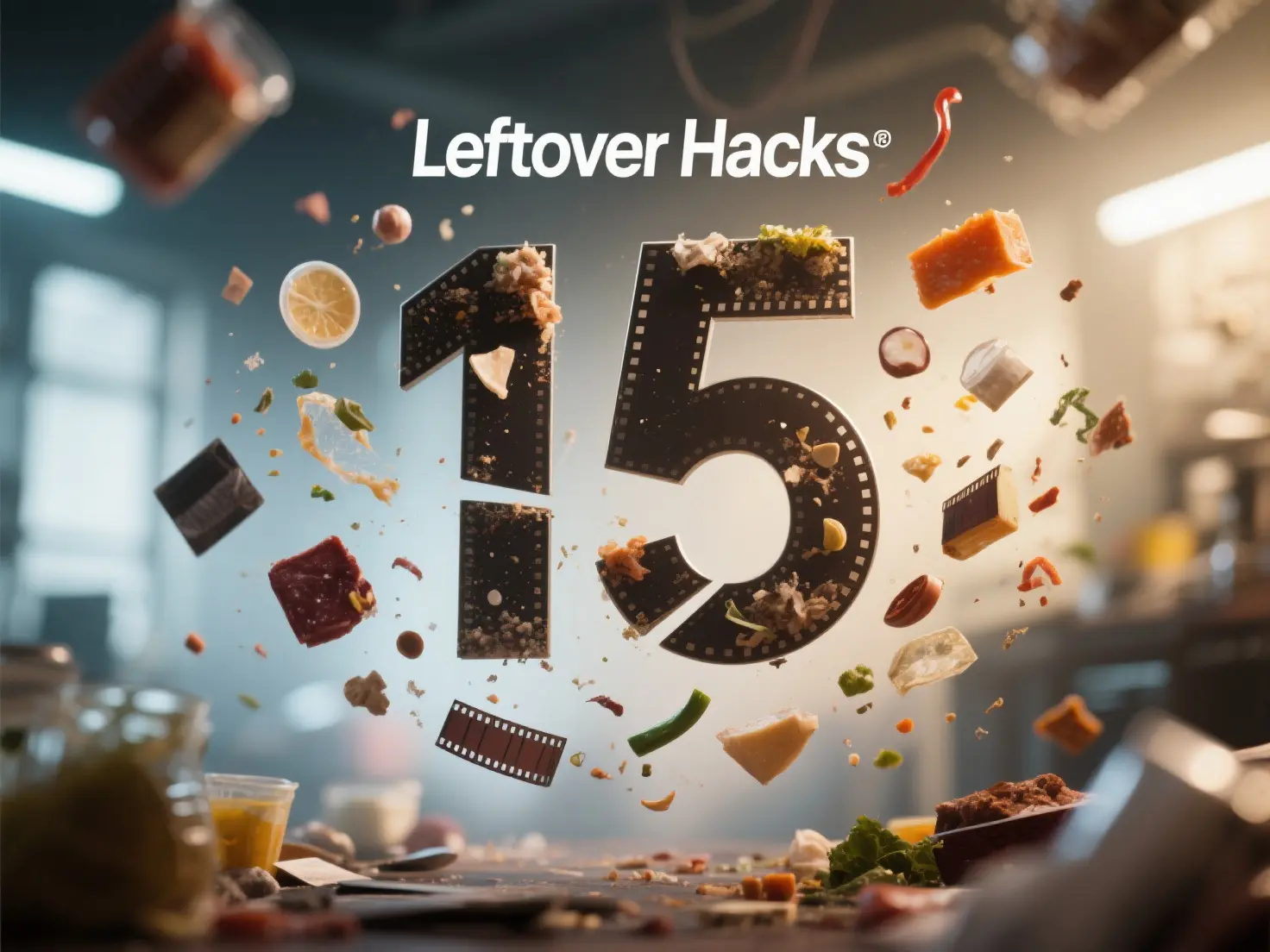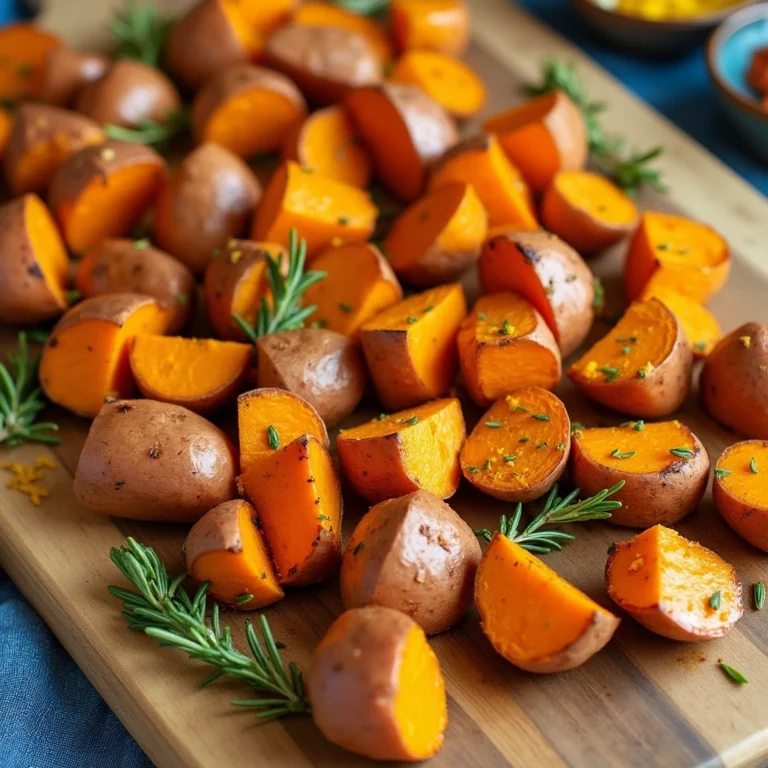How to Master 15 Leftover Hacks Every Family Should Know
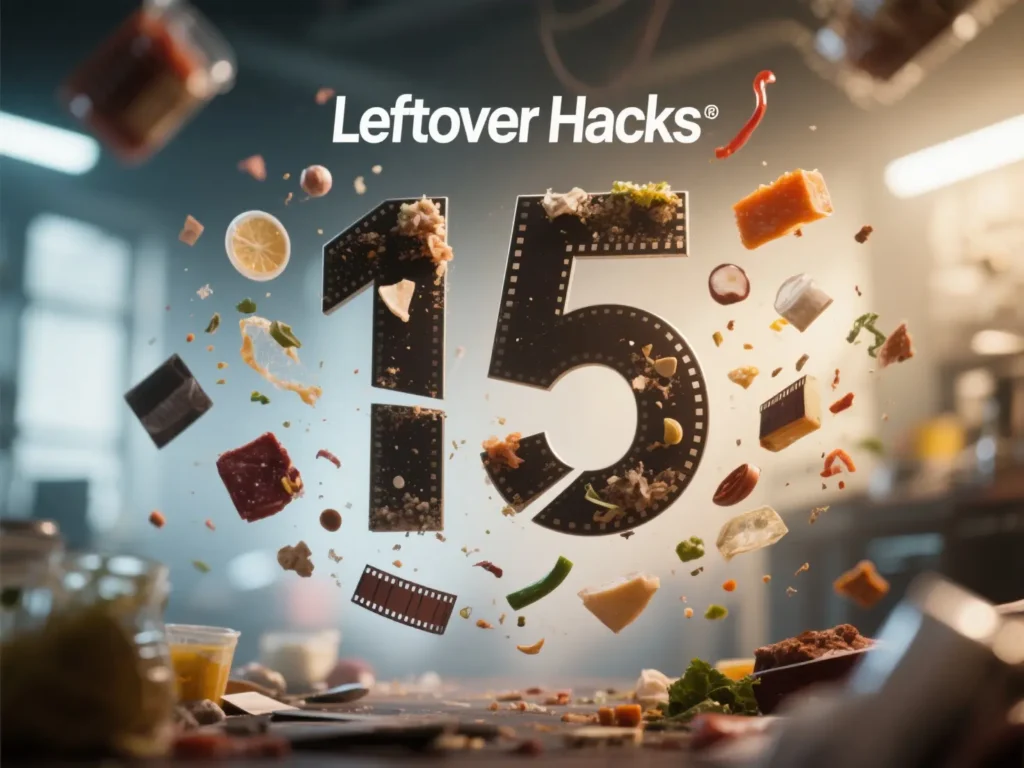
Table of Contents
Have you ever opened your fridge after a big meal, only to stare blankly at a collection of containers, wondering what to do with all those delicious but seemingly unappetizing leftovers? It’s a common dilemma!
The thought of throwing away delicious food can feel wasteful, yet reheating the same dish day after day loses its appeal. What if we told you that those lonely leftovers aren’t just remnants of yesterday’s meal, but hidden treasures waiting to be transformed into exciting, brand-new dishes? Imagine a world where food waste is minimal, your grocery budget stretches further, and every meal feels fresh and innovative. Get ready to discover simple, clever tricks that will turn you into a kitchen wizard, making the most of every delicious morsel!
“Leftovers aren’t scraps—they’re tomorrow’s solutions.”
Key Insights into Leftover Transformation
- Creative Reinvention: Leftover hacks are not just about reheating; they are about transforming ingredients into entirely new and exciting meals, preventing food boredom and waste.
- Simplicity and Accessibility: These techniques are designed to be easy, quick, and require no advanced culinary skills or special equipment, making them perfect for busy families and beginner cooks.
- Economic and Environmental Benefits: By maximizing the use of existing food, families can significantly reduce grocery expenses and contribute to lowering food waste, benefiting both their wallets and the planet.
The Art of Leftover Reinvention: An Overview
The concept of “leftover hacks” is all about embracing creativity and resourcefulness in the kitchen. It’s a sustainable approach to cooking that not only saves money but also significantly reduces food waste, a growing concern in many households. These aren’t just vague suggestions; they are practical, fun, and most importantly, delicious ways to give your cooked food a second, third, or even fourth life.
What makes these hacks truly special is their universal appeal and ease of implementation. You don’t need to be a Michelin-star chef or possess an arsenal of fancy gadgets. Many of these transformations require only a few minutes of preparation, often leveraging ingredients you already have on hand. The difficulty level is remarkably low, making them accessible to everyone, from culinary novices to seasoned home cooks looking for fresh inspiration.
Imagine turning last night’s roasted chicken into a vibrant taco filling, or yesterday’s plain rice into a savory fried rice masterpiece. These hacks are designed to morph your existing ingredients into exciting dishes your family will genuinely enjoy, time and time again. It’s about viewing your refrigerator not as a graveyard for forgotten food, but as a pantry brimming with potential!
Essential Building Blocks for Leftover Magic
The beauty of leftover hacks lies in their flexibility. While specific recipes might call for particular items, the core principle is to work with what you have. However, certain categories of ingredients form the backbone of many successful leftover transformations. Understanding these core components and their versatility is key to becoming a master of culinary improvisation.
“Feeding your family doesn’t always mean starting from scratch.”
Your Foundational Ingredients
- Cooked Grains (Rice, Pasta, Quinoa): These are incredibly versatile. Leftover rice is the perfect base for fried rice or rice bowls. Cooked pasta can be reimagined into pasta bakes or frittatas. Quinoa adds a healthy, protein-rich element to salads or stuffings.
- Leftover Proteins (Chicken, Beef, Pork, Fish, Beans): Whether it’s shredded roast chicken, diced beef, or even cooked lentils, proteins are central to many new dishes. They can be chopped, shredded, or warmed to become fillings for tacos, wraps, salads, or components in casseroles and soups.
- Cooked Vegetables (Roasted, Steamed, Sautéed): Don’t let those stray broccoli florets or roasted carrots go to waste! Incorporate them into soups, omelets, frittatas, stir-fries, or blend them into sauces. Even slightly wilted salad greens can be quickly stir-fried with garlic.
- Breads & Wraps (Sandwich Bread, Tortillas, Pittas, Flatbreads): Stale bread can be resurrected as croutons, breadcrumbs, or even a savory bread pudding. Tortillas and pitas are excellent for quick quesadillas, wraps, or mini pizzas.
- Dairy & Eggs (Cheese, Milk, Yogurt, Eggs): Eggs are a binding agent and a meal in themselves, perfect for frittatas, scrambles, or adding richness to fried rice. Cheese melts wonderfully, adding comfort and flavor to almost any re-invented dish, from casseroles to quesadillas.
- Fruits (Soft or Firm): Overripe fruits can be blended into smoothies, baked into muffins or breads, or made into quick fruit salads.
- Sauces & Condiments (Marinara, Pesto, Gravy, Dressings): A flavorful sauce can instantly elevate leftovers, making them taste entirely new. A dollop of pesto, a splash of soy sauce, or a drizzle of dressing can tie disparate ingredients together.
Embracing Substitutions and Variations
The true spirit of leftover hacking is adaptability. Don’t feel constrained if you don’t have a specific ingredient. Here are some tips for variations:
- Protein Swaps: Vegetarian? Tofu, tempeh, or various beans and lentils are fantastic substitutes for meat.
- Grain Alternatives: No rice? Use couscous, quinoa, or even small pasta shapes.
- Dairy-Free Options: Use avocado or hummus as creamy bases instead of cheese or dairy in some applications. Plant-based milks can often substitute cow’s milk in baking or sauces.
- Flavor Boosts: Experiment with different herbs and spices. A pinch of chili flakes can add heat, while fresh cilantro can brighten flavors.
The key is to look at what’s available in your fridge and pantry with a playful and experimental mindset. Every item holds potential for a delicious new creation!
15 Incredible Leftover Hacks to Master
Now that you’re familiar with the foundational ingredients, let’s dive into 15 specific, easy-to-follow hacks that will transform your kitchen and delight your family. Each hack is designed to be quick, simple, and incredibly rewarding.
Category 1: Rice and Grain Transformations
Hack 1: The Fried Rice Masterpiece

What makes it special? This is a classic for a reason! Leftover rice, which can be a bit dry, becomes wonderfully flavorful and fluffy when stir-fried. It’s a quick, one-pan meal that can incorporate almost any leftover protein or vegetable.
- Ingredients: Cooked rice, diced leftover meat (chicken, pork, ham), mixed vegetables (peas, carrots, corn, or leftover cooked veggies), 1-2 eggs, soy sauce, a touch of oil (sesame or vegetable), garlic, and ginger (optional).
- Steps: Heat oil in a large skillet or wok over medium-high heat. Add chopped garlic and ginger (if using), then your diced meat and cooked vegetables, stir-frying for a few minutes. Push ingredients to one side, crack eggs into the other, and scramble. Once scrambled, mix with other ingredients. Add cooked rice and a generous splash of soy sauce. Stir-fry vigorously until everything is heated through and well combined, about 5-7 minutes.
- Tip: Day-old, slightly dry rice works best as it won’t clump together. For extra flavor, add a few drops of sesame oil at the very end.
Hack 2: Crispy Rice Bites (or Patties)

What makes it special? These little bites are a fantastic snack or side dish, offering a delightful texture contrast. They’re easy to customize and kid-friendly.
- Ingredients: Cooked rice, 1 egg, grated cheese (optional), salt, pepper, a pinch of dried herbs, and breadcrumbs (for extra crispiness).
- Steps: In a bowl, combine rice, egg, cheese (if using), salt, pepper, and herbs. Mix well. Form small balls or flatten into small patties. If desired, roll them in breadcrumbs. Heat a little oil in a non-stick pan over medium heat. Cook the rice bites for 3-5 minutes per side until golden brown and crispy.
- Tip: Serve with ketchup, sriracha mayo, or a sweet chili sauce. You can also bake them at 400°F (200°C) for a healthier option, about 15-20 minutes, flipping halfway.
Category 2: Protein Power-Ups
Hack 3: Magic Quesadillas or Wraps
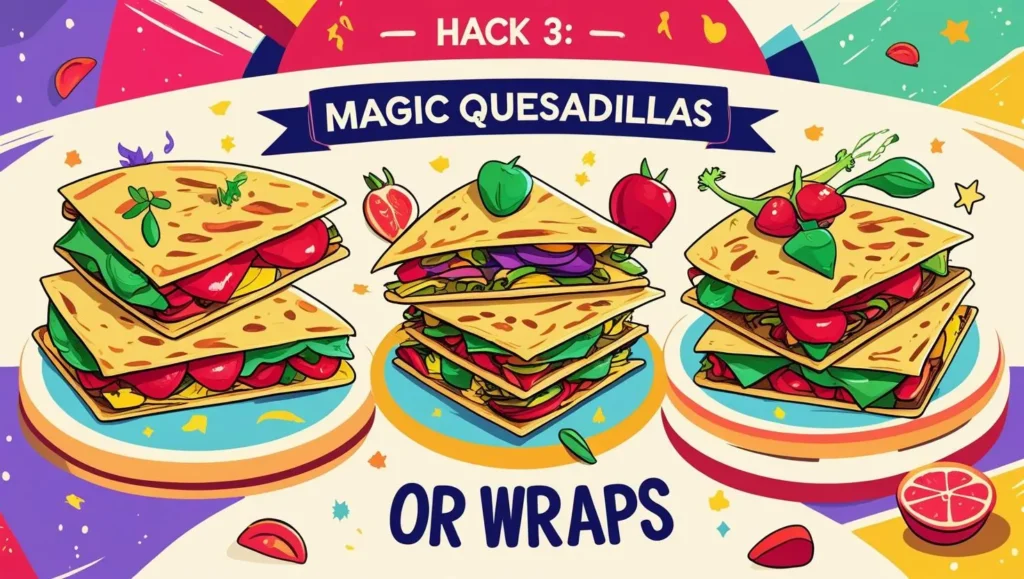
What makes it special? Quick, cheesy, and incredibly versatile, quesadillas are a go-to for using up small amounts of cooked meat, beans, and veggies.
- Ingredients: Tortillas, shredded or diced cooked chicken/beef/pork, cheese (shredded cheddar, Monterey Jack), cooked vegetables, black beans (optional).
- Steps: Lay a tortilla in a dry skillet over medium heat. Sprinkle half the tortilla with cheese, then add your chosen fillings (meat, veggies, beans). Sprinkle more cheese over the fillings. Fold the other half of the tortilla over. Cook for 2-3 minutes per side until golden brown and the cheese is melted and bubbly.
- Tip: Serve with salsa, sour cream, or guacamole. For wraps, simply load a tortilla with fillings and roll tightly.
Hack 4: Soup from Scraps
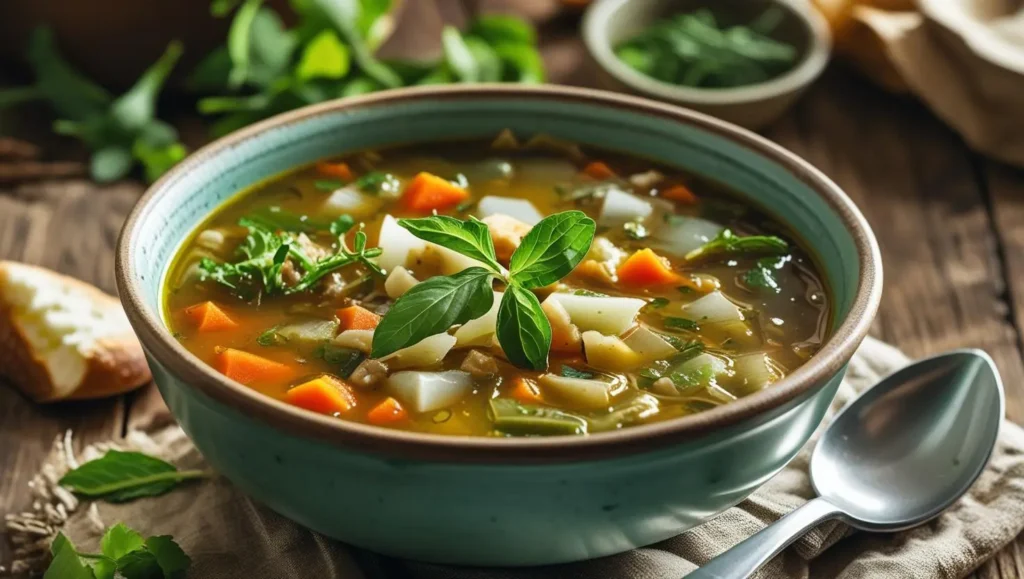
What makes it special? A comforting, nourishing meal that breathes new life into leftover bones, vegetables, and meat bits. It’s incredibly economical.
- Ingredients: Leftover roasted chicken carcass or beef bones, cooked vegetables, small pieces of cooked meat, broth (chicken or vegetable), herbs (thyme, bay leaf), salt, pepper.
- Steps: Place leftover bones (if using) in a large pot with water to cover, and simmer for an hour to make a quick stock. Strain out bones. Add cooked vegetables, chopped meat, and additional broth (if needed) to the pot. Simmer until heated through and flavors meld, about 15-20 minutes. Season to taste.
- Tip: For a creamy soup, blend a portion of the soup or stir in a splash of milk or cream at the end. Add pasta or rice during the last few minutes of simmering for a heartier meal.
Hack 5: Casserole Creation
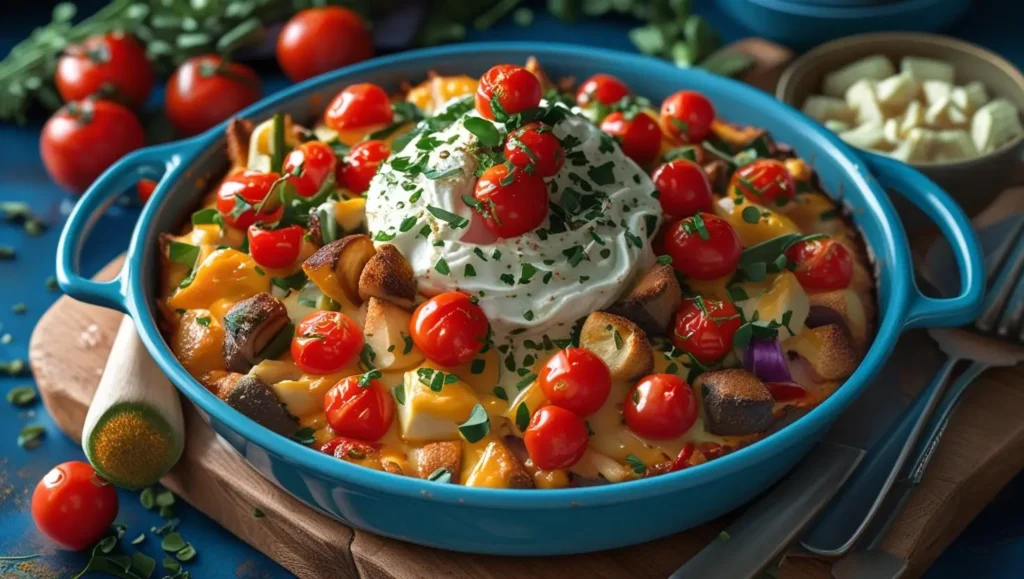
What makes it special? Casseroles are the ultimate comfort food, perfect for combining various leftovers into a cohesive, bake-and-forget meal.
- Ingredients: Leftover cooked pasta or rice, chopped cooked protein (chicken, beef, tuna), cooked vegetables, a creamy sauce (canned soup, homemade béchamel, or even canned diced tomatoes), and cheese.
- Steps: Preheat oven to 375°F (190°C). In a large bowl, combine pasta/rice, protein, vegetables, and sauce. Mix well. Pour into a baking dish. Top generously with cheese. Bake for 20-30 minutes, or until bubbly and heated through, and the cheese is golden.
- Tip: Add breadcrumbs mixed with melted butter on top for a crunchy topping.
Category 3: Vegetable and Egg Enhancements
Hack 6: Egg Muffins for On-the-Go

What makes it special? These individual egg bites are perfect for meal prep, healthy breakfasts, or quick snacks, easily customizable with whatever veggies or meats you have.
- Ingredients: 6-8 eggs, milk (a splash), salt, pepper, chopped cooked vegetables (spinach, peppers, onions), diced cooked ham or bacon (optional), and shredded cheese.
- Steps: Preheat oven to 350°F (175°C). Lightly grease a muffin tin. Whisk eggs with milk, salt, and pepper. Distribute chopped veggies, meat, and cheese evenly among the muffin cups. Pour egg mixture over the fillings, filling cups about two-thirds full. Bake for 15-20 minutes, or until set and lightly golden.
- Tip: Store cooled egg muffins in an airtight container in the fridge for up to 3-4 days. Reheat briefly in the microwave.
Hack 7: The Versatile Frittata or Omelet
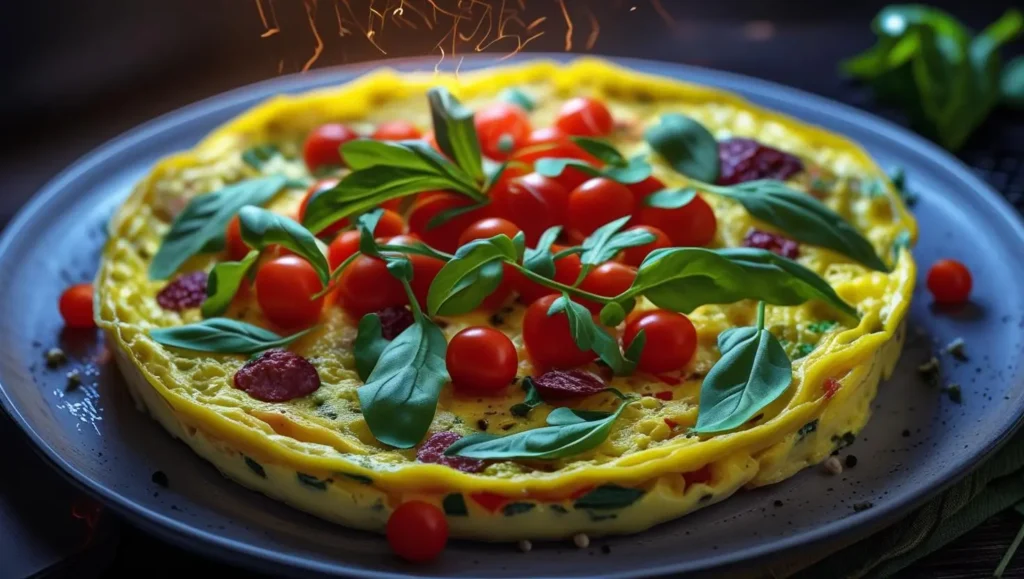
What makes it special? A quick and elegant way to use up small amounts of cooked vegetables and proteins. Great for any meal of the day.
- Ingredients: Eggs, a splash of milk or cream, salt, pepper, cooked vegetables (broccoli, mushrooms, potatoes), cooked meat (sausage, chicken), and cheese (optional).
- Steps (Frittata): Whisk eggs, milk, salt, and pepper. Sauté any raw veggies if using, then add cooked veggies and meat to an oven-safe, non-stick skillet. Pour the egg mixture over. Cook on stovetop until edges set (about 5 minutes), then transfer to preheated oven (350°F/175°C) for 10-15 minutes until puffed and set.
- Steps (Omelet): Whisk eggs, milk, salt, and pepper. Heat a non-stick pan over medium heat. Pour egg mixture into pan, tilting to coat. As edges set, push cooked egg towards the center, letting uncooked egg flow underneath. When mostly set but still slightly moist on top, add fillings to one half. Fold over and serve.
- Tip: Avoid overfilling an omelet. For a frittata, you can add a sprinkle of fresh herbs at the end.
Category 4: Bread and Pizza Makeovers
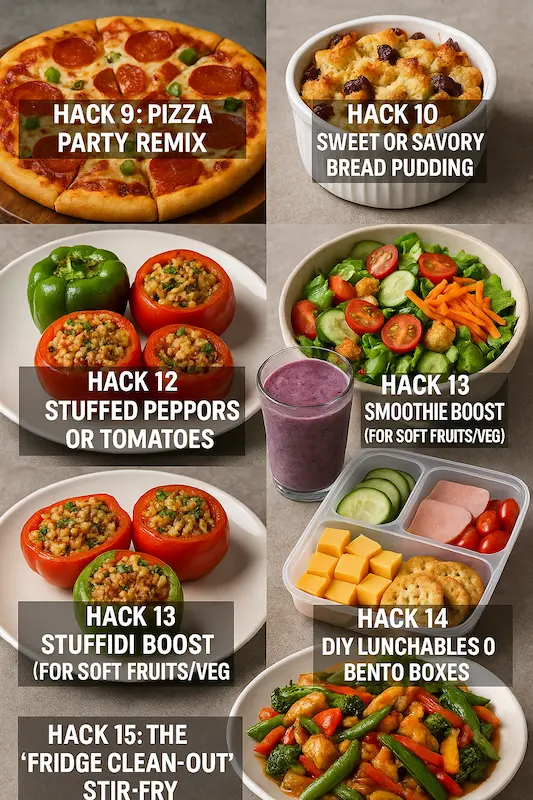
Hack 8: Stale Bread to Crouton Gold
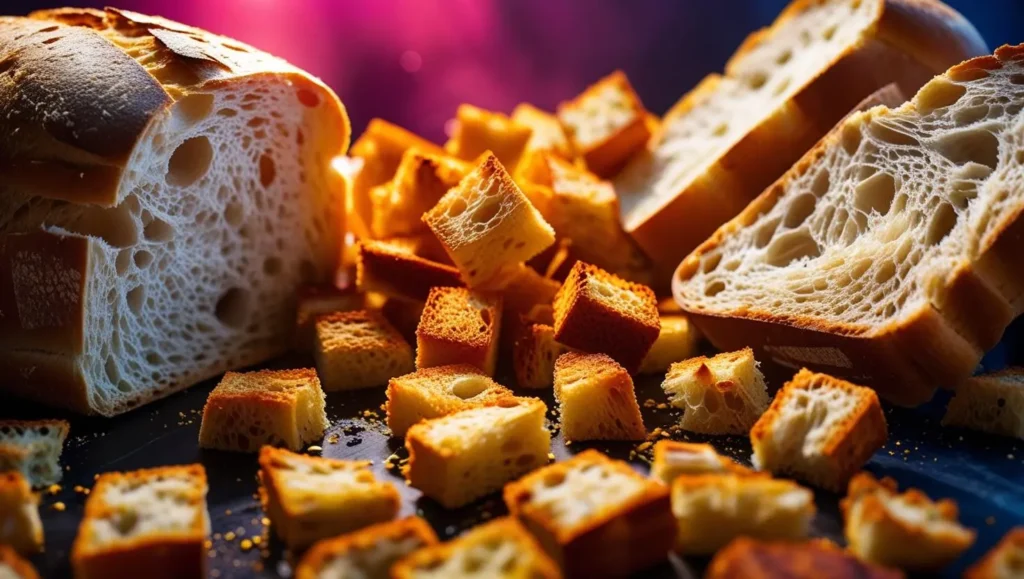
What makes it special? Transforms dry, unappealing bread into crunchy, flavorful additions for salads and soups.
- Ingredients: Stale bread (any type), olive oil, garlic powder, dried herbs (oregano, basil), salt, pepper.
- Steps: Preheat oven to 300°F (150°C). Cut bread into 1-inch cubes. In a bowl, toss bread cubes with olive oil, garlic powder, herbs, salt, and pepper until evenly coated. Spread in a single layer on a baking sheet. Bake for 15-20 minutes, stirring occasionally, until golden brown and crispy.
- Tip: Store in an airtight container for up to a week. For breadcrumbs, simply pulse the toasted cubes in a food processor.
Hack 9: Pizza Party Remix
What makes it special? Gives leftover pizza a fresh, new identity beyond just reheating slices.
- Ingredients: Leftover pizza slices, extra cheese (optional), and any additional toppings (pepperoni, veggies).
- Steps:
- Oven Reheat: Preheat oven to 375°F (190°C). Place pizza on a baking sheet and bake for 8-10 minutes until cheese is melted and crust is crispy.
- Skillet Reheat: Place a pizza slice in a cold non-stick skillet. Cover with a lid and heat over medium-low for 5-7 minutes. The lid traps steam to melt cheese, while the bottom gets crispy.
- Pizza Sandwich: Place a slice of pizza on a flatbread or large tortilla, add extra cheese and toppings, then top with another slice of pizza or flatbread. Grill in a panini press or skillet until heated through and cheese is melted.
- Tip: Don’t microwave pizza unless you like soggy crust. The oven or skillet methods yield superior results.
Hack 10: Sweet or Savory Bread Pudding
What makes it special? A delightful way to use up stale bread, transforming it into a comforting dessert or a hearty savory dish.
- Ingredients (Sweet): Stale bread cubes, eggs, milk, sugar, vanilla extract, cinnamon, dried fruit, or chocolate chips.
- Ingredients (Savory): Stale bread cubes, eggs, milk, cheese, cooked sausage/bacon, chopped cooked veggies, salt, pepper, and herbs.
- Steps: Preheat oven to 350°F (175°C). Whisk eggs with milk, seasonings/sugar, and vanilla (for sweet). Add bread cubes and chosen fillings (fruit/chocolate for sweet, meat/veg for savory) and mix well, ensuring bread soaks up the liquid. Pour into a greased baking dish. Bake for 30-40 minutes until golden brown and set.
- Tip: For savory, top with extra cheese before baking. For sweet, serve with a scoop of ice cream or a drizzle of maple syrup.
Category 5: The “Any Leftover” Lifesavers
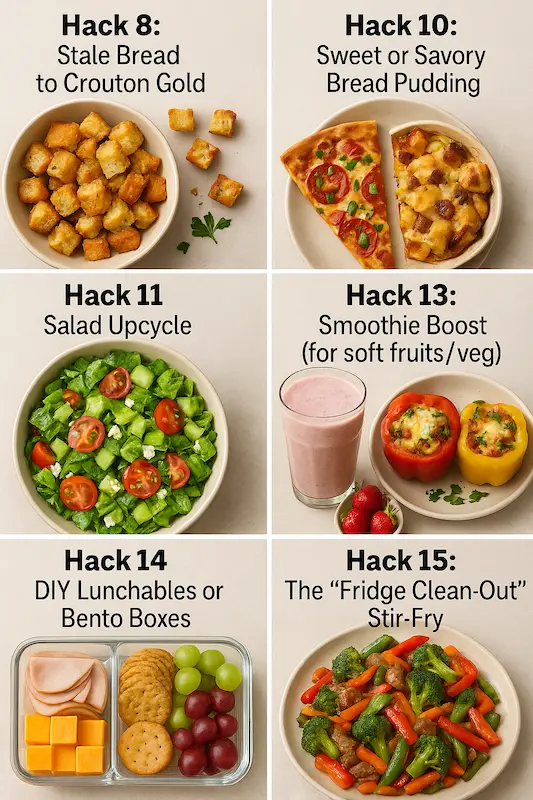
Hack 11: Salad Upcycle
What makes it special? Transforms individual components into a fresh, vibrant, and light meal, perfect for lunch.
- Ingredients: Any chopped cooked protein, cooked grains, roasted or steamed vegetables, fresh greens, nuts/seeds (optional), dressing.
- Steps: Combine all chopped leftover components in a bowl with fresh greens. Toss with your favorite dressing. Add nuts or seeds for crunch, if desired.
- Tip: Keep dressing separate until just before eating to prevent greens from wilting.
Hack 12: Stuffed Peppers or Tomatoes
What makes it special? An impressive and flavorful dish that’s easy to prepare, perfect for showcasing a medley of leftovers.
- Ingredients: Bell peppers (halved) or large tomatoes (hollowed), cooked rice, cooked ground meat or lentils, chopped cooked vegetables, marinara sauce, and cheese.
- Steps: Preheat oven to 375°F (190°C). In a bowl, mix cooked rice, meat/lentils, veggies, a little marinara sauce, and some cheese. Spoon the mixture into pepper halves or hollowed tomatoes. Place in a baking dish with a splash of water at the bottom. Bake for 30-40 minutes, or until peppers are tender and filling is heated through. Top with extra cheese during the last 10 minutes.
- Tip: You can precook the pepper halves slightly for a softer texture.
Hack 13: Smoothie Boost (for soft fruits/veg)
What makes it special? A quick, healthy way to use up overripe fruits or a handful of greens before they go bad.
- Ingredients: Soft fruits (berries, bananas, mango), a handful of spinach or kale, yogurt or milk (dairy or non-dairy), honey or maple syrup (optional), ice.
- Steps: Combine all ingredients in a blender. Blend until smooth. Add more liquid if too thick, or more ice for a colder, thicker smoothie.
- Tip: Peel and freeze overripe bananas to use in smoothies later.
Hack 14: DIY Lunchables or Bento Boxes
What makes it special? A fun, customizable, and visually appealing way to pack lunches for kids (and adults!), using small portions of various leftovers.
- Ingredients: Cooked meat slices, cheese cubes, crackers, fruit slices, raw veggie sticks, and small portions of pasta salad or rice.
- Steps: Arrange small, appealing portions of different leftovers in a bento box or divided container. Focus on variety in color and texture.
- Tip: Involve kids in choosing their components for a personalized lunch.
Hack 15: The “Fridge Clean-Out” Stir-Fry
What makes it special? The ultimate flexible meal, designed to use up all the odds and ends in your fridge before grocery day.
- Ingredients: Any small amounts of cooked meat or tofu, various raw or cooked vegetables (broccoli, carrots, bell peppers, onions, mushrooms, cabbage), a quick stir-fry sauce (soy sauce, ginger, garlic, honey/sugar, rice vinegar, cornstarch slurry), cooked rice or noodles for serving.
- Steps: Heat oil in a large skillet or wok over high heat. Add harder raw vegetables first, stir-frying until slightly tender-crisp. Add softer raw vegetables and any cooked veggies/meat, stir-frying until heated through. Pour in stir-fry sauce and cook until thickened. Serve immediately over rice or noodles.
- Tip: Don’t overcrowd the pan, as this steams rather than stir-fries. Cook in batches if necessary.
Navigating Leftover Hacks: Key Tips and Best Practices
Beyond the individual recipes, mastering leftover hacks involves adopting smart habits and a proactive approach to food management. These general tips will help you maximize your success and ensure food safety.
Smart Storage and Organization
- Clear Containers Are Your Friends: Store leftovers in transparent containers. “Out of sight, out of mind” often leads to forgotten food. If you can see it, you’re more likely to use it.
- Label and Date Diligently: Always label containers with the food item and the date it was cooked. This helps you track freshness and prioritize what needs to be used first.
- Portion for Purpose: When initially cooking, consider cooking extra of basic components like plain rice or roasted chicken. Store these in portion sizes, making them easy to grab for future hacks.
Cooking and Preparation Techniques
- Taste as You Go: When reinventing leftovers, taste and adjust seasonings. The original dish’s flavors might have changed, or new ingredients require balancing.
- Don’t Overcook: Most of your components are already cooked, so the goal is to reheat and integrate, not to cook from scratch. Avoid overcooking to maintain texture and flavor.
- Embrace the Freezer: Not all leftovers need to be eaten immediately. Many cooked components (like shredded chicken, cooked beans, or pureed vegetable soups) freeze beautifully for busy weeks ahead. Portion them before freezing for easy access.
- Batch Basic Components: Consider cooking larger quantities of staples like rice, quinoa, or roasted vegetables at the beginning of the week. This provides a ready supply of “building blocks” for quick transformations.
Food Safety First!
While creativity is encouraged, food safety is paramount. Follow these guidelines to ensure your leftover transformations are not only delicious but also safe:
- Cool Quickly: Refrigerate cooked food within two hours of cooking. Divide large quantities into smaller, shallow containers to help them cool faster.
- Store Properly: Keep leftovers in airtight containers in the refrigerator (at 40°F/4°C or below) for no more than 3-4 days.
- Reheat Thoroughly: Always reheat leftovers to an internal temperature of 165°F (74°C). Bring soups and sauces to a rolling boil.
- When in Doubt, Throw It Out: If food looks, smells, or tastes questionable, it’s safer to discard it.
Understanding the Impact: Food Waste and Savings
Beyond the culinary adventure, embracing leftover hacks has significant benefits for your household budget and the environment. Food waste is a substantial issue globally, contributing to greenhouse gas emissions and economic losses. By cleverly repurposing your leftovers, you directly contribute to solving this problem.
Economic Benefits of Smart Leftover Management
Imagine the cumulative savings over a year if you consistently use up all your edible food instead of discarding it. Here’s how leftover hacks contribute to your financial well-being:
- Reduced Grocery Bills: You buy less because you’re using more of what you already have.
- Maximized Investment: Every ingredient you purchase is utilized to its fullest potential, ensuring you get the most value for your money.
- Fewer Takeout Meals: Having appealing leftover options readily available can reduce the temptation to order expensive takeout or dine out on busy nights.
To illustrate the potential impact, consider the following bar chart, representing the potential for savings and waste reduction when actively implementing leftover hacks.
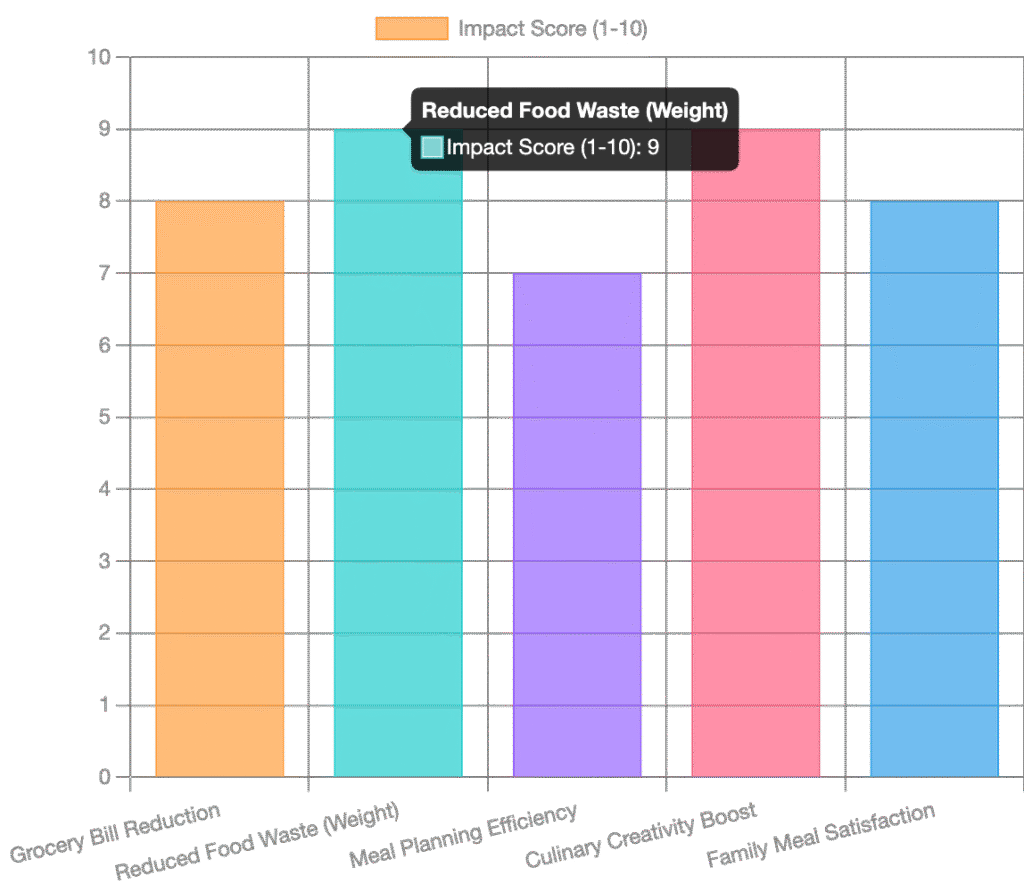
Environmental Implications of Food Waste
Reducing food waste is a powerful way to make a positive environmental impact. When food is discarded, it not only represents the waste of water, energy, and resources used to produce it, but also contributes to landfill methane emissions, a potent greenhouse gas. By extending the life of your food, you’re directly contributing to a healthier planet.
Dive Deeper: Visualizing Leftover Potential
For more inspiration and practical demonstrations on how to make the most of your leftovers, this video from Gordon Ramsay offers valuable tips on how to best utilize those fridge finds. It’s a great visual guide to complement the hacks discussed.
Understanding Leftover Categories and Their Best Uses
To further streamline your leftover game, here’s a table summarizing common leftover categories and their prime uses, along with simple preparation notes. This table acts as a quick reference guide when you’re staring into your fridge.
| Leftover Category | Examples | Best Transformation Uses | Quick Prep Notes |
|---|---|---|---|
| Cooked Grains | Rice, Pasta, Quinoa | Fried rice, pasta bakes, grain bowls, stir-fries, stuffed vegetables | Stir-fry with sauce; mix into casseroles; add to soups for thickness |
| Cooked Proteins | Chicken, Beef, Pork, Fish, Lentils | Tacos/burritos, salads, sandwiches, soups, casseroles, frittatas | Shred or dice; add to hot dishes; serve cold in wraps/salads |
| Cooked Vegetables | Roasted, Steamed, Sautéed Veggies | Soups, omelets, frittatas, stir-fries, sauces (pureed), quiches | Chop and add to eggs; blend into creamy soups; quick sauté with new flavors |
| Bread & Baked Goods | Stale Bread, Tortillas, Muffins | Croutons, breadcrumbs, bread pudding (sweet/savory), mini pizzas, wraps | Toast/bake for croutons; blend for crumbs; soak for puddings |
| Dairy & Eggs | Cheese, Yogurt, Cooked Eggs | Quesadillas, egg muffins, frittatas, topping for bakes, smoothies | Melt on dishes; whisk with other ingredients for bakes; blend into drinks |
| Fruits | Overripe Berries, Bananas, Apples | Smoothies, muffins, quick breads, fruit sauces, infused water | Blend into drinks; mash for baking; simmer for simple sauces |
Frequently Asked Questions About Leftover Hacks
What is the safest way to store leftovers?
The safest way to store leftovers is in airtight containers in the refrigerator within two hours of cooking. Make sure to consume them within 3-4 days.
Can all leftovers be reheated multiple times?
While some foods can be reheated more than once, it’s generally safest to reheat food only once. Ensure it reaches an internal temperature of 165°F (74°C) each time.
How can I make leftovers taste fresh and new?
To make leftovers taste fresh, focus on changing their form, adding new textures, or introducing new flavors. For example, transform roasted vegetables into a frittata, or add fresh herbs and a new sauce to leftover pasta.
Are there any leftovers I should avoid reusing?
Certain foods, like rice, require careful handling due to potential bacterial growth if not cooled and reheated properly. Seafood should also be consumed within a day or two and reheated thoroughly. Always use your judgment: if it smells or looks off, it’s best to discard it.
What’s the best way to get kids involved in leftover hacks?
Involve kids by letting them choose ingredients for DIY lunchables, helping to form rice patties, or assisting with simple tasks like mixing and stirring. Making it a fun, creative process encourages participation and reduces pickiness.
Conclusion: Your Kitchen, Reimagined
Congratulations, future leftover master! You are now equipped with the knowledge and tools to transform your kitchen from a place of potential waste into a hub of innovation and deliciousness. By embracing these 15 simple, family-friendly hacks, you’re not just cooking; you’re engaging in a sustainable practice that saves money, reduces your environmental footprint, and unlocks endless culinary creativity.
Remember, every single leftover has untapped potential. Whether it’s a few spoonfuls of rice, a lone chicken breast, or some aging vegetables, each item can become the star of a brand-new meal. Don’t be afraid to experiment, mix and match, and customize these ideas to suit your family’s tastes. The journey of mastering leftover hacks is a rewarding one, promising not only fantastic meals but also a deeper appreciation for the food we consume. So, the next time you open your refrigerator, ask yourself: “What delicious surprise can I create today?” Happy hacking!
🍲 The average U.S. family of four wastes around 400 pounds of food per year (USDA).
🧾 Food is the largest category of waste in U.S. landfills.
💡 Top wasted items? Cooked rice, pasta, vegetables, bread, and meat—perfect for leftover hacks!
🔁 Just 3 leftover-based meals per week can save 5–8 hours of cooking time monthly.
🌍 Reducing food waste is the #1 most effective solution for fighting climate change (Project Drawdown).
Recommended Further Exploration
- Discover more creative ways to reduce food waste at home.
- Explore effective meal planning tips for busy families.
- Find budget-friendly family recipes using common pantry staples.
- Learn how to properly store different types of food to maximize freshness.
Referenced Search Results
bhf.org.uk
15 thrifty ways to use your leftovers – Heart Matters – BHF
buzzfeed.com
27 Ways To Turn Leftover Foods Into A New Meal – BuzzFeed
foodandwine.com
14 Ways to Transform Leftovers Into New Meals – Food & Wine
bbcgoodfood.com
10 dinners which make great lunch leftovers – BBC Good Food
reddit.com
What is your favourite way to make leftovers into new meals? – Reddit
ecothriftyliving.com
15 Ways to Avoid Throwing Away Leftover Food – Eco Thrifty Living
shelfcooking.com
Shelf Cooking – comprehensive tips and tricks to maximize leftovers
hennepin.us
What to do with leftover food – Hennepin County
ceceliahealth.com
Creative Ways to Use Leftovers to Save You Time and Money – Cecelia Health
lovebakerstreet.com
Creative Leftover Recipes To Tackle Food Waste – Baker Street
cosmopolitan.com
10 Mind-Blowing Hacks for Making Your Leftover Pizza Taste Better the Next Day
familyhandyman.com
49 Life Hacks You’ll Wish You Knew Sooner | Family Handyman
bbcgoodfood.com
Leftovers recipes – BBC Good Food
foodnetwork.com
20 Best Leftover Steak Recipes & Ideas | How to Use Up Leftover …
reddit.com
What’s a dinner that gets your family excited for leftovers? – Reddit
quora.com
What is the best way to handle leftover food after a large family …
olivemagazine.com
10 money-saving hacks to use up food leftovers | olivemagazine
takethemameal.com
Five Ways To Use Leftovers – Take Them A Meal
lifeasagriffin.com
Home Hacks: Tips & Tricks for Every Family — Life As A Griffin
chowhound.com
This Shockingly Simple TikTok Hack Will Keep Your Restaurant Leftovers Secure – Chowhound
familyhandyman.com
Vintage Home Hacks That Are Just As Brilliant Today
hildaskitchenblog.com
Leftover Steak Recipe Ideas | Hilda’s Kitchen Blog
realliferealkitchen.com
The Beginner’s Guide to Leftovers – Real Life. Real Kitchen.
icy-veins.com
Crafting DoH Master Books Guide – Final Fantasy XIV – Icy Veins
familyhandyman.com
These 20 Household Hacks Will Make Life So Much Easier
frugalfunmom.com
How To Get Your Family To Eat Leftovers & Like It!
eatingwell.com
23 Recipes That Are Even Better as Leftovers
buzzfeed.com
24 “Wish I Knew This Yesterday” Life Hacks That Changed Everything For The People Who Tried Them
frugalandthriving.com.au
Meals From Leftovers: 7 Frugal Master Recipes with Leftover Food
ffxivgillionaire.com
Collectables & Master Recipe Book Guide – Gillionaire Girls
thekitchn.com
20 Meals That Make Great Leftovers – The Kitchn
nomoneynotime.com.au
Managing food supplies and using leftovers to minimise food waste | No Money No Time
allrecipes.com
15 Recipes We Think Are Better as Leftovers – Allrecipes
247-foodrecipes.com
busycooks.com
How to Make Steak Fried Rice (with Leftover Steak) – Busy Cooks
pinterest.com
92 Leftover Hacks ideas | recipes, food, cooking – Pinterest
wea.org.uk
reddit.com
What are your favorite double-it/leftovers meals? : r/Mommit – Reddit
bustle.com
9 Leftover Hacks That Will Help You Save Money
boredpanda.com
lovefoodhatewaste.com
whatsgabycooking.com
17 Dinner Recipes That Make Great Leftover Lunches – What’s Gaby …
ffxiv.consolegameswiki.com
Master Recipe Tomes – Final Fantasy XIV Online Wiki – FFXIV / FF14 …
lifesorted.com
Large Family Organization: 17 Clever Hacks for Domestic Bliss – Life Sorted
bbc.co.uk
The recipes you need to master to reduce your food waste – BBC Food
everydaycheapskate.com
What to Do With Leftover Green Salad: 9 Genius Ideas • Everyday Cheapskate
nourishingminimalism.com
7 Time Saving Hacks for Big Families – Nourishing Minimalism
tasteofhome.com
57 Kitchen Hacks You’ll Wish You Knew Sooner | Taste of Home
